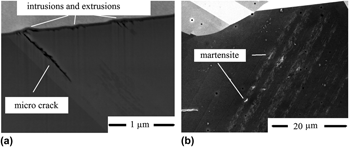Published online by Cambridge University Press: 08 August 2017

Two austenitic stainless steels of strongly different stacking fault energies (SFEs) and correspondingly different stabilities of the austenite phase were studied with respect to their very high cycle fatigue (VHCF) behavior. The metastable austenitic stainless steel 304L shows a very pronounced transient behavior and a fatigue limit in the VHCF regime. The higher SFE of the 316L steel results in a less pronounced transient cyclic deformation behavior. The plastic shear is more localized, and the formation of deep intrusions leads to microcrack initiation. However, the propagation of such microcracks is impeded by α′-martensite formed very localized within the shear bands. A comprehensive description of the microstructural changes governing the cyclic deformation including the transient resonant behavior was developed and transferred into a mechanism-based model. Simulation results were correlated with the observed deformation evolution and the change of the resonant behavior of specimens during VHCF loading providing a profound understanding of the VHCF-specific deformation behavior.
Contributing Editor: Mathias Göken